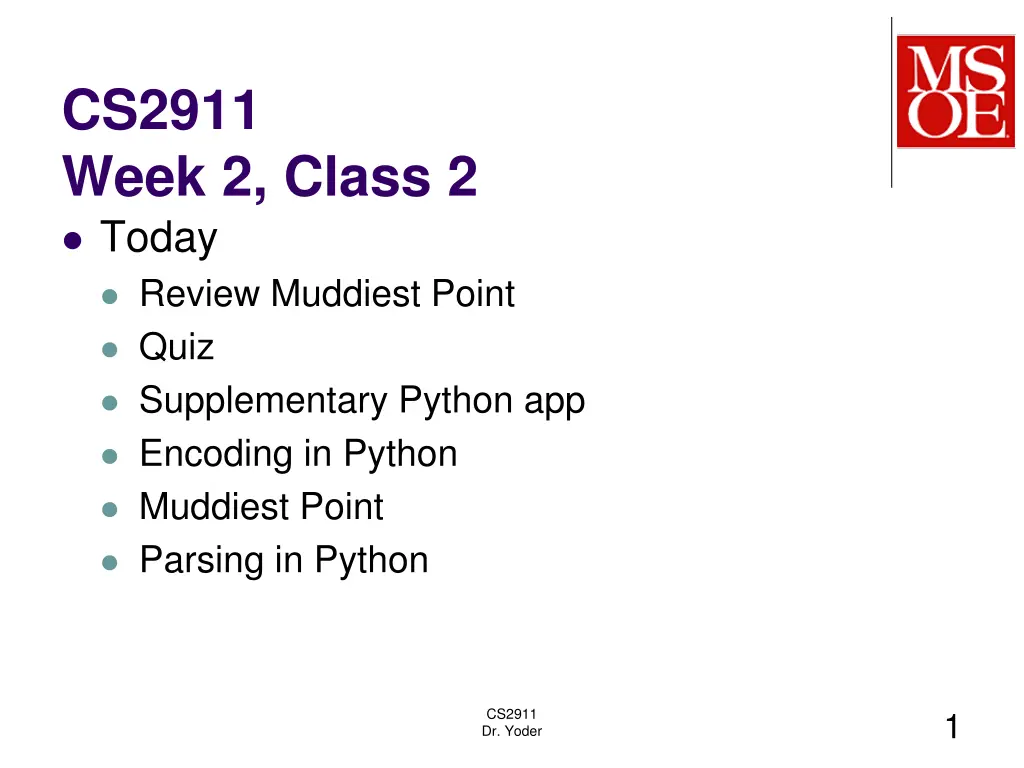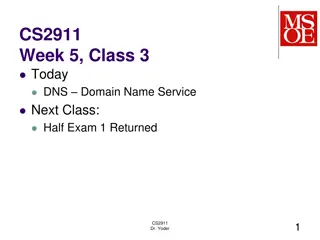
Python Programming: Review, Lab Questions, and Supplementary Materials
Dive into Python concepts such as encoding, decoding, ASCII, lab procedures, and more through a collection of images. Enhance your Python skills with quizzes, exercises, and additional learning resources. Get insights on integers and string storage in Python.
Uploaded on | 1 Views
Download Presentation

Please find below an Image/Link to download the presentation.
The content on the website is provided AS IS for your information and personal use only. It may not be sold, licensed, or shared on other websites without obtaining consent from the author. If you encounter any issues during the download, it is possible that the publisher has removed the file from their server.
You are allowed to download the files provided on this website for personal or commercial use, subject to the condition that they are used lawfully. All files are the property of their respective owners.
The content on the website is provided AS IS for your information and personal use only. It may not be sold, licensed, or shared on other websites without obtaining consent from the author.
E N D
Presentation Transcript
CS2911 Week 2, Class 2 Today Review Muddiest Point Quiz Supplementary Python app Encoding in Python Muddiest Point Parsing in Python CS2911 Dr. Yoder 1
Muddiest Point 2-1 and Lab 2 It's very unclear what we actually have to code in Lab 3. So what exactly is ord should the pre-lab be printed? And today wasnt too muddy. Im getting better at converting between binary and hex everything was clear for me Lab 3 ord/chr Lab 2 none keyword arguments Using the keyword arguments Do you want our predictions for the lab printed out, or is a digital format sufficent Why is 5 stored as 53? Lab 2 ASCII decimal 2
Quiz 1 3
Supplementary Python materials http://www.sololearn.com/Play/Python Learn Python app from SoloLearn Available for Android and iPhone Supplementary If you learn something here that is missing in class, please tell me Quizzes and interactive environment may be helpful Alternative: Redo an SE1011 lab with Python Note: We are not doing OO in Python this quarter 4
Questions about Lab 3? Design process How to implement in Python? Protocol definition 5
Exercise: Brainstorm steps (large or small) needed to complete Lab 3 6
Python 3 types int str bytes b'123' raw bytes or ASCII string 123 '123' integer (any size) Unicode string UPDATED NEXT LECTURE 7
How integers are stored conceptually in Python i = 5 101 i = 255 11111111 i = 1000 1111101000 i = 2147483647 1111111111111111111111111111111 8 class 1-2: Slide 21
How strings are conceptually stored in in Python s = '0123' 00000 00000000 00110000 00000 00000000 00110001 00000 00000000 00110010 00000 00000000 00110011 9 class 1-2: Slide 27
Arbitrary byte literals 5 = 0x05 b'\x05' # 0000 0101 14 = 0x0e b'\x0e' # 0000 1110 100 = 0b110 0100 = 0x64 b'\x64' # 0110 0100 10
How bytes are stored in Python (Length is also stored) s = b'ABC' 01000001 01000010 01000011 s = b'0123' 00110000 00110001 00110010 00110011 s = b'\r\n' 00001101 00001010 11
ord() and chr() i = 5 # int literal # 101 s = chr(i) # 00000 00000000 00000101 s = 'a' # str literal # 00000 00000000 01100001 i = ord(s) # 1100001 12 Class 1-2: Slide 28
bytes can be sliced like strings b = b'ABC' # 01000001 01000010 01000011 b[1:3] # 01000010 01000011 # b'BC' But not indexed like strings! b[0] # .000000000001000001 # 65 (an integer) 13
Converting between strings and bytes # Use UTF-8 for the byte string # If a non-ASCII characters is used in s, # multiple bytes in b will replace it. s = bytes.decode(b) b = s.encode() # Use ASCII for the byte string # Only ASCII characters can be used in s s = bytes.decode(b,'ASCII') b = s.encode('ASCII') 14
int() and str() s = b'1234' # 00000 00000000 00110001 # 00000 00000000 00110010 # 00000 00000000 00110011 # 00000 00000000 00110100 i = int(s) # 10011010010 15
int() and str() i = 999 # 11 11100111 s = str(i) # 00000 00000000 00111001 # 00000 00000000 00111001 # 00000 00000000 00111001 16
int(,16) s = '1AFF' # 00000 00000000 00110001 # 00000 00000000 01000001 # 00000 00000000 01000110 # 00000 00000000 01000110 i = int(s,16) # 1 1010 1111 1111 17
format(,'x') i = 0xAFF # 1010 11111111 s =format(i,'04x') # 00000 00000000 00110000 # 00000 00000000 01100001 # 00000 00000000 01100110 # 00000 00000000 01100110 # ('0aff') 18
.to_bytes() i = 0xAFF = 281510 # 1010 11111111 b = i.to_bytes(2,'big') # 00001010 11111111 # b'\n\xff' i2 = int.from_bytes(b,'big') # class method # 1010 11111111 19
Keyword Arguments You can include the names of the parameters as "keywords" on your arguments: b = i.to_bytes(length=2, byteorder='big') # length number of bytes to produce in b i2 = int.from_bytes(bytes=b, byteorder='big') # This can help make code self-documenting 20
Review b'\xbe\xef' = 1011 1110 1110 1111 (as bytes) 0xbeef = 1011 1110 1110 1111 (as int) ( ).to_bytes( ,byteorder='big') int.from_bytes( ,byteorder='big') ord( ) chr( ) int( ) format( ,'x') 21
Question Why might int( ) and format( ) be less efficient than the others for creating a raw encoding? 22
Exercise: Work on Lab 3 Write method headers with documentation Decide who will write each method Try to figure out what the "hard" parts will be 24
Python byte lists and strings Python 3.x bytes # ASCII string, array of bytes bytearray # Mutable list of bytes str # Unicode string Python 2.7 str bytearray unicode 25
Acknowledgement This course is based on the text Computer Networking: A Top Down Approach 7th edition Jim Kurose, Keith Ross Addison-Wesley 26

